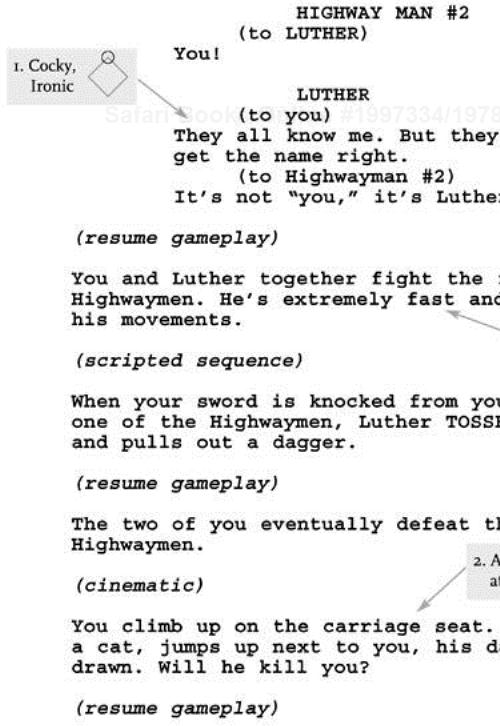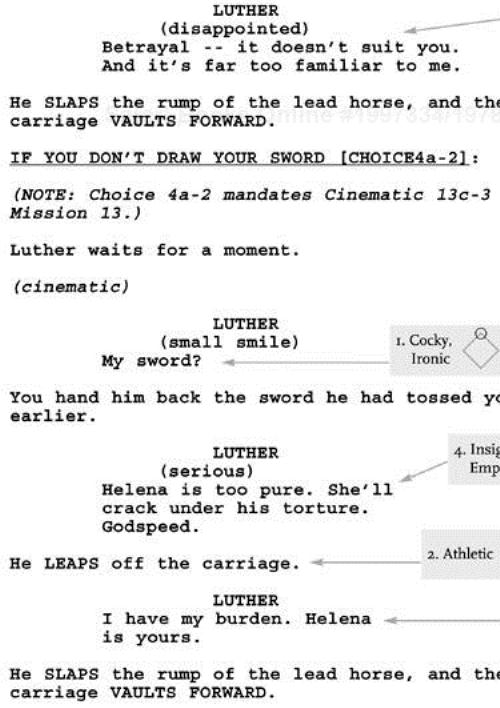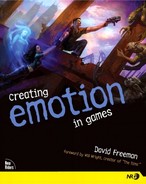Boring people never rock your world, and they always leave before the party gets good.
This chapter deals
with techniques to make major NPCs interesting. The term “NPC Interesting Techniques” at first seems awkward. It makes sense to call a technique that makes an NPC deep an “NPC Deepening Technique.” If a technique makes an NPC interesting, however, it sounds awkward to call it an “NPC Interesting Technique.” Still, this makes more sense than calling it an “Interesting NPC Technique,” for then the technique itself sounds interesting, instead of the technique being about a way to make an NPC interesting.
Thus you'll find many places in this book where the word “interesting” is used after the noun it describes (“NPC Interesting Techniques,” “Plot Interesting Techniques,” and so on), just as “Deepening” is used after these same nouns.
If you wouldn't invite a bore to your dinner gathering or marry one off to your daughter, sister, or pet, then don't put one in your games.
Boredom comes in many forms. Sometimes the problem is that the NPCs have no interesting characteristics, so they radiate all the sizzle of a Hallmark get-well card.
Other times, though, the game designer or writer has gone trolling through the over-fished waters of Tolkien or Lucas, and has dredged up some poor character who's dying of overexposure. The game designer proceeds to stick this Gandolf or Han Solo knock-off in his game and smile as he watches us gag on his freshly-minted cliché.
If you want to sustain emotional immersion in your game, then don't let boring NPCs jar the player out of the flow.
This chapter discusses techniques that make major NPCs dimensional, fresh, and thus interesting.
People are dimensional, and your NPCs should be too, especially the important ones.
For major NPCs, I create what I call a Character Diamond.

I try to give all major NPCs at least four different Traits—that is, one for each of the four corners of their Diamonds. For instance, say you have a Greek warrior. He's:
I call the preceding attributes of the NPC his “Traits.” A Trait is a major facet of the character's personality, and thus governs how the character sees the world, thinks, speaks, and acts.
All of the character's action and speech is guided by his or her Character Diamond, except for situationally appropriate emotions. For instance, if your Greek warrior was attacked, he might get angry, even though anger isn't one of his core Traits. But it would be situationally appropriate.
If the NPC trips a lot, that isn't a Trait. It's irrelevant as to how the NPC sees the world, thinks, and speaks.
On the other hand, a characteristic such as “Reckless” can be a Trait. If it's an important aspect of the character's core personality, then it affects how that character sees the world, thinks, speaks, and acts.
The Character Diamond is like an architectural blueprint. When building a house, you follow the blueprint. When creating a major NPC, the NPC's dialogue and actions conform to the Traits of the Diamond.
Let's say your character's Traits are:
Heroic
Loyal
Honest
Ethical
Would this NPC have a Diamond?
Yes, but a very boring one.
A cliché character is one who has a combination of Diamond Traits that we've frequently seen before in film, TV, or game characters. Even more commonly, cliché characters don't have three, four, or five familiar Traits, but rather just one or two—for example, a villain who is Cunning and Vicious.
Thus, we find that a cliché space pilot who's a knockoff of Han Solo has Diamond Traits that make him:
Swashbuckling
Brave
Have a dry wit
A bit arrogant
A cliché knockoff of Gandolf would be an NPC with a Diamond comprised of the Traits:
Magical
Mysterious
Good
Wise
A major NPC doesn't need to have four Traits to be interesting. Three would be enough.

An NPC can also have five Traits. More than five for an NPC might easily turn the character to “mush.” That is, it might be hard to get a strong feeling for who this character actually is.

While major characters with five Traits aren't uncommon in film and television, even the most important NPCs are rarely around long enough so that you can easily squeeze in five Traits without their identities becoming confusing to a player. This isn't to say it can't be done, for it absolutely can. It just means proceed with caution.
If a character has three major Traits, or even five, I still call this combination the character's Diamond. (I use the word “Diamond” because four Traits is the most common number, and because it's easy to remember. You just need to wrap your mind around the idea of a three-sided Diamond or a five-sided one.)
While it isn't a hard and fast rule, your main characters will probably have more Traits than your minor characters.
Remember, a Trait can be manifested in action, dialogue, or both.
Here's an example. Let's say you're playing an action-adventure game with a swashbuckling, Three Musketeers type of feeling.
A character named Luther is your rival, but your relationship with him is complex. He might later become a friend.
His Diamond is that he's:
Cocky, ironic
Incredibly athletic and a superb swordsman, beautiful to watch in action
Touched by a deep sadness, which might be fueled by guilt
Keenly insightful into and empathetic with people
Sneaky and stealthy
The way Luther speaks, the choices he makes, even the way he fights—all these will be determined by his Diamond.
(begin gameplay) EXT. DIRT ROAD THROUGH THE FOREST - NIGHT You're driving a stagecoach at night on a muddy dirt road lined by dense trees. You're moving at top speed because you heard Helena is in danger. You need to steer the stagecoach to avoid fallen logs, pits in the road, etc., that could overturn the coach. (cinematic) FOUR HIGHWAYMEN step out from the trees. They block your path. The horses stop and rear up. The Highwaymen pull out pistols. HIGHWAYMAN #1 (to you; coolly threatening) Sweet night for a ride. Suddenly, the end of a WHIP wraps around a high branch, and Luther SWINGS OUT onto the road, holding onto the handle of the whip. In his swing, he KNOCKS OVER Highwayman #1. HIGHWAY MAN #2 (to LUTHER) You! LUTHER (to you) They all know me. But they never get the name right (to Highwayman #2) It's not "you," it's Luther. (resume gameplay) You and Luther together fight the four Highwaymen. He's extremely fast and fluid in his movements. (cinematic) Your sword is knocked from your hand. (scripted sequence)[1] When your sword is knocked from your hand by one of the Highwaymen, Luther TOSSES you his and pulls out a dagger. You try to catch his sword. If you don't, you need to pick it up, but this exposes you to attack from the Highwaymen. (resume gameplay) The two of you eventually defeat the Highwaymen. (cinematic) You climb up on the carriage seat. Luther, like a cat, jumps up next to you, his dagger still drawn. Will he kill you? (resume gameplay) IF YOU DRAW YOUR SWORD [CHOICE 4a-1]:[2] (NOTE: Choice 4a-1 mandates Cinematic 13c-2 in Mission 13.) Then you two fight on the stagecoach for 45 seconds. (cinematic) He then jumps off the stagecoach. LUTHER (disappointed) Betrayal -- it doesn't suit you. And it's far too familiar to me. He SLAPS the rump of the lead horse, and the carriage VAULTS FORWARD. IF YOU DON'T DRAW YOUR SWORD [CHOICE4a-2]: (NOTE: Choice 4a-2 mandates Cinematic 13c-3 in Mission 13.) Luther waits for a moment. (cinematic) LUTHER (small smile) My sword? You hand him back the sword he had tossed you earlier. LUTHER (serious) Helena is too pure. She'll crack under his torture. Godspeed. He LEAPS off the carriage. LUTHER I have my burden. Helena is yours. He SLAPS the rump of the lead horse, and the carriage VAULTS FORWARD. (resume gameplay) NO MATTER WHICH OF THE PRECEDING CHOICES IS MADE BY THE PLAYER: You must continue to steer the carriage around various obstacles without tipping it over. This time, your task is made more difficult, because other HIGHWAYMEN occasionally shoot at you from between the trees. If you're hit or if you don't kill at least one of them with your pistol, then you won't make it to Helena in time.
Normally, I don't go out of my way to put every corner of a character's Diamond in every sequence. I did it this time just as an illustration.
Let's look at the sequence again, picking out Luther's Diamond corners. Remember that he's:



The idea of creating Character Diamonds seems easy. Yet, in one of my most recent screenwriting classes, most of students struggled to create interesting Diamonds. Here are few guidelines:
Remember that we're only talking about major NPCs here, not minor ones.
In giving an NPC different Traits, we're not trying to make a character “well rounded” by somehow “balancing” the Traits. For instance, you don't give the character a “strong” Trait (Being a Leader) and then “balance” this with a “soft” Trait” (Having a Spiritual Take on Life).
Nor is the idea to confuse the player as to who his friends are and who the bad guys are by making NPCs ambiguous, unless you desire this effect.
Nor is the idea to balance out likable (or virtuous) and unlikable (or evil) Traits.
What's important is that major NPCs are interesting, and this requires at least three Traits that form a colorful grouping.
If a major NPC is designed with three or more Traits, but we go through long stretches without seeing a Trait manifested in the NPC's dialogue or behavior, then, to the player, that Trait might just as well not exist. The major NPC, without at least three Traits actively being used, will effectively have too few Traits and probably won't be very interesting.
If you design a major NPC with three or more Traits, but the NPC starts saying or doing things not characterized by those Traits, then that NPC will seem like incomprehensible mush. You've strayed from the blueprint.
There are two exceptions to this: One, as explained earlier, is “situational emotions.” That is, an NPC might not have “Angry” as a Trait, but that NPC could still get angry if the situation called for it.
The other exception is when an NPC grows emotionally and changes, and so one or more of his/her Traits change. This circumstance will be covered in Chapter 2.9, “NPC Character Arc Techniques.”[3]
“If all you need is a colorful grouping of Traits to make an interesting major NPC,” one game designer asked me, “then why not put a list of Traits up on the wall and throw darts? Whichever three, four, or five Traits the darts hit, you could use for a Diamond.”
He might be right; this could potentially create an interesting character. I doubt, though, that random chance would create a useful character for your game.
Picking the Traits is where the art comes in. Many factors might weigh in on the selection, but ultimately it's up to the person who creates the character to make the difficult choices. I can teach craft; I can't teach art. This is exactly why I and so many other professional writers study the work of writers we admire: to examine what choices they made and to try to discern the thinking behind those choices.
Personally, I give very serious consideration to the Traits I pick when creating a major NPC's Diamond. Sometimes I use a list of several thousand Traits I've assembled to help spark ideas. I deliberate on the choices, because I, the other designers, and ultimately the players are going to have to live with these characters for a long time.
Let's go back to that NPC who trips a lot. I've already mentioned that tripping over things wouldn't be a Trait.
Tripping frequently would be a “quirk.” A quirk is something that gives individuality to an NPC without being as important as a Trait.
By using the word “quirk,” I don't mean that the behavior needs to be extreme or odd. It's merely something less important than a Trait. If an NPC likes jazz, that's also a quirk. It doesn't measure up to the importance of a Trait.
Quirks are another way of making NPCs interesting.
Minor NPCs don't need three or more Traits. Two, or even one, can be sufficient.
At a minimum, these Traits need to be interesting and unexpected for such a character. If the NPC has two Traits, at least one needs to be interesting and unexpected.
For example: You lead a platoon, and one soldier is always depressed, but in a slightly funny way. He has just one Trait—Depressed in a Funny Way—but it's interesting.
You could argue that this is two Traits: Depressed and Funny. That would be true, if he was funny on a regular basis. If the funniness is just part of his depression and doesn't emerge anywhere else, then it's simply a modifier of Depressed.
Modifying Traits is fine. Just try to be clear to yourself whether you're modifying one Trait or adding a second one. Either case is fine; it's just helpful to know exactly what you're doing.
Or let's say you have an air traffic controller in your flight sim (simulation) game. He's a minor NPC. Give him two Traits, such as Sarcastic and Easily Excited, and have a sufficiently interesting character.
Let's go back to our soldier who was Depressed in a Funny Way. Could you give him just one Trait (Depressed)? Sure, and he could still be interesting. But the key there would be to make sure that his dialogue isn't a cliché. (See Chapter 2.3, “Dialogue Interesting Techniques.”)
I've been given this line more than once by game designers and publishers. The thinking goes like this: If the NPC is a clichè such as a “mafia type,” then the player can instantly figure out “who the character is.”
My argument is always the same: If people hate clichés in films and they hate clichés in television, then I refuse to believe that the minute they start playing a game, all their standards change and they're suddenly overcome by inexplicable longings for rehashed characters and formulaic dialogue.
The techniques presented here to create viable and artful Character Diamonds and make NPCs interesting just scratch the surface. Going into all their facets would add far too many pages and be too specialized, but here are a few last points to consider:
You should give thought as to whether or not you want any of your NPCs to have Traits in common.
There are matters of false fronts. Sometimes an NPC will have one Trait, such as arrogance, that covers up another Trait, such as insecurity. I call these false fronts “Masks.”
Sometimes an NPC might struggle against one or more of his Traits. For instance, a solider might be a coward but struggle to be brave. This takes fairly sophisticated writing to communicate artfully.
Character Diamonds, or combining even a couple of interesting Traits, are useful techniques for creating interesting villains. Other methods besides Diamonds, however, can make villains more dimensional and lifelike, and therefore emotionally engaging. You can humanize them by seeing the fears or emotional wounds that drive them. You can reveal tiny pieces of their lives outside their acts of villainy. You can clue us in to their motivations, which, even though they're heinous sounding to us, make sense to them.
But don't humanize a villain too much or the player will feel guilty for killing him or her, which in most cases is undesirable. On the other hand, if your villain is to change sides at some point and become good, then perhaps giving him or her more “humanity” in the beginning will make the player both be reluctant to kill the villain, and be glad when the villain changes sides.
Traits and quirks can act in harmony or can fight a bit with each other. If they fight too much, the character will be unfocused. For example: A character who likes to have things “organized” (a Trait), always keeps his car messy (a quirk). These two seem to fight each other and will blur our sense of who the character is.
If the character likes to keep things organized, but misplaces his keys on a regular basis, that doesn't fight his Trait of “being organized” too much and would probably work—although there's still the possibility that you'll confuse the player as to who the character is.
Usually, quirks don't fight or harmonize with a Trait. They simply add more detail to the character, as in a character who is always organized (a Trait) and who enjoys watching baseball games (a quirk).
There's always something more to learn in this, or in any other art form, but if you keep these Character Diamond techniques in mind, you should have a solid basis from which to begin.
[1] The definition of "scripted sequence" is too long and involved to insert here. Please see the definition in the Glossary
[2] The numbers used in this example don't refer to anything specific here; they're inserted to merely to represent the kind of flow-chart system commonly found in game scripts.
[3] A Character Arc is the rocky path of growth a character undergoes in a story, usually unwillingly, during which the character wrestles with and eventually overcomes some or all of a serious emotional fear, limitation, block, or wound. Some examples are: a character overcoming a lack of courage, overcoming a lack of ethics, learning to love, learning to take responsibility for others, or over coming guilt.
